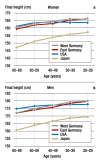Growth and puberty in German children: is there still a positive secular trend?
- PMID: 19623318
- PMCID: PMC2712240
- DOI: 10.3238/arztebl.2009.0377
Growth and puberty in German children: is there still a positive secular trend?
Abstract
Background: Since the mid-19th century, growth in German children has accelerated and final height increased. Possible causes of this secular trend include improvements in nutrition, hygiene, and health care. While the upward secular trend still continues in some parts of the world, it seems to be slowing in industrialized countries.
Methods: Selective literature review.
Results: Reliable data on growth that have been published since the middle of the 19th century reveal an increase in final height by 1 to 2 cm per decade in most European countries. Recent epidemiological studies, however, suggest that human height may be nearing an upper limit, beyond which it cannot increase even with further improvements in nutrition and health care. In Germany and other northern European countries, the upward trend in final height has slowed significantly over the last 30 years; in Germany, it now stands at less than 1 cm/decade. In the same interval, the age at menarche has remained constant at just under 13 years (currently 12.8).
Conclusions: In Germany, as elsewhere in northern Europe, the upward secular trend in height is slowing (ca. 2 cm/decade up to the mid-20th century, currently less than 1 cm/decade), and the age at menarche has stabilized at just under 13 years. It remains an open question whether the observed slowing will merely be temporary, or whether it indeed represents the near-attainment of an endpoint owing to relatively stable environmental conditions.
Keywords: child health; growth; puberty; quality of life; short stature.
Figures




Comment in
-
Consumption of milk as a vital factor in growth development.Dtsch Arztebl Int. 2009 Oct;106(40):656; author reply 656. doi: 10.3238/arztebl.2009.0656a. Epub 2009 Oct 2. Dtsch Arztebl Int. 2009. PMID: 19890432 Free PMC article. No abstract available.
References
-
- van Wieringen JC. Secular growth changes. In: Falkner F, Tanner JM, editors. Human growth: a comprehensive treatise. Ed 2. vol.3 Methodology Ecological, Genetics and Nutritional Effects on Growth. New York: Plenum Press; 1986. pp. 307–331.
-
- Brundtland GH, Liestol K, Walloe L. Height, weight, and menarcheal age of Oslo schoolchildren during the last 60 years of life. Ann Hum Biol. 1982;9:521–537. - PubMed
-
- Tanner JM. Growth as a mirror of conditions in society. In: Lindgren GW, editor. Growth as a mirror of conditions in society. Stockholm: Stockholm Institute of Education Press; 1999. pp. 9–48.
-
- Hauspie RC, Vercauteren M, Susanne C. Secular changes in growth and maturation: an update. Acta Paediatr Suppl. 1997;423:20–27. - PubMed
Publication types
MeSH terms
LinkOut - more resources
Full Text Sources
Medical

